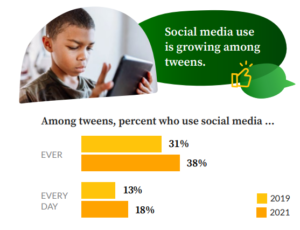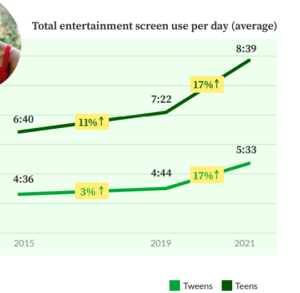 Social media has developed into something quite powerful and predominant in the lives of youth nowadays. These digital natives born in an era where they are surrounded by technology, rely heavily on social media as a way to stay connected and informed. Almost all teens have some form of social media they are signed up to use and we can attest to the fact that they use it regularly. Instagram, Snapchat, TikTok and Facebook seem to be among some of the more popular platforms; watching online videos is also ranked as a favourite pastime for both tweens and teens (Common Sense Census, 2021). Whether or not we understand our youth’s fascination with social media, I think we can all agree that over the years the interest in social media platforms has increased and will most likely continue to increase in the future.
Social media has developed into something quite powerful and predominant in the lives of youth nowadays. These digital natives born in an era where they are surrounded by technology, rely heavily on social media as a way to stay connected and informed. Almost all teens have some form of social media they are signed up to use and we can attest to the fact that they use it regularly. Instagram, Snapchat, TikTok and Facebook seem to be among some of the more popular platforms; watching online videos is also ranked as a favourite pastime for both tweens and teens (Common Sense Census, 2021). Whether or not we understand our youth’s fascination with social media, I think we can all agree that over the years the interest in social media platforms has increased and will most likely continue to increase in the future.
Social Media is fast becoming a popular communication tool used worldwide. In 2021, the Common Sense Census revealed that 94% of tweens and teens had a smartphone which facilitates having access to different social media platforms. Smartphones and social media platforms are creating opportunities for our youth to stay connected with one another and as it was mentioned in this week’s debate, social media platforms are providing our teens with opportunities to engage in different social interactions with each other. Having a big chunk of my family in South America, I can vouch for how social media platforms have allowed me to connect with family members across the globe and to get a glimpse at their lives even though we’re not in the same country. During our debate this week, it was mentioned that social media can also build a sense of community while providing instances of support to teens from vulnerable groups. Furthermore, we are seeing more instances of youth having their voices heard, advocating for others, and coming together to organize movements for change through the use of social media in this digital age. In my EC&I 822 class last semester we revealed
“that young people perceive social media as a platform for expression and communication” (Cortés-Ramos et al., 2021, p. 10).
Additionally, “given [our] social nature, human beings have a constant need for interacting, cooperating, and communicating with others to work towards [satisfying our] multiple needs” (Cortés-Ramos et al., 2021, p. 1). The possibilities seem endless when we consider all the favourable opportunities that can arise from using social media.
 However, with endless amounts of possibilities, comes an abundant amount of risks as well. As discussed during our debate this week, ensuring our children’s online safety becomes an issue when dealing with social media and it can be difficult to determine the context of our youth’s interactions on these platforms. While some children are engaging in healthy forms of interactions on social media by lending their support to others and various social movements, many children use this platform to engage in cyberbullying. “In a national study of over 1500 students aged 10-15, 33% experienced online harassment [over the course of the] year” (Charmaraman et. al., 2021). Additionally, Sebastián Bortnik’s TED Talk explains the troubling truth behind grooming and how it is linked to the use of social media. This TED Talk explains the risks our children and teens can encounter using the internet and it mentions how easily we are allowing strangers to have access to our children through social media. Researchers are also expressing their concern about social media lending to anxiety disorders, depression, suicides, and problematic attachment behaviours to social media such as FOMO (the Fear Of Missing Out) where teens are compulsively checking their phones constantly. Finally, there are also some discrepancies when we consider younger children bypassing age restrictions to allow them access to different social media platforms; “a UK study found that 73% of 10-12-year-olds had signed up for social media despite the age restrictions” (Charmaraman et. al., 2021).
However, with endless amounts of possibilities, comes an abundant amount of risks as well. As discussed during our debate this week, ensuring our children’s online safety becomes an issue when dealing with social media and it can be difficult to determine the context of our youth’s interactions on these platforms. While some children are engaging in healthy forms of interactions on social media by lending their support to others and various social movements, many children use this platform to engage in cyberbullying. “In a national study of over 1500 students aged 10-15, 33% experienced online harassment [over the course of the] year” (Charmaraman et. al., 2021). Additionally, Sebastián Bortnik’s TED Talk explains the troubling truth behind grooming and how it is linked to the use of social media. This TED Talk explains the risks our children and teens can encounter using the internet and it mentions how easily we are allowing strangers to have access to our children through social media. Researchers are also expressing their concern about social media lending to anxiety disorders, depression, suicides, and problematic attachment behaviours to social media such as FOMO (the Fear Of Missing Out) where teens are compulsively checking their phones constantly. Finally, there are also some discrepancies when we consider younger children bypassing age restrictions to allow them access to different social media platforms; “a UK study found that 73% of 10-12-year-olds had signed up for social media despite the age restrictions” (Charmaraman et. al., 2021).
 Social media is rapidly becoming an integral part of our children’s lives. Everywhere we turn there seems to be a new social media platform being launched that is calling out to youth to try it out. I honestly do not see our children ceasing to use social media in the future. If we refer to the Common Sense Census from 2021, the average entertainment screen time used by tweens and teens was 8 hours and 39 minutes per day and it was up 17% from 2019. I do feel like eight hours is a little excessive when we are talking about healthy screen time use for youth and I believe that a healthy balance between tech time use and non-tech time use would benefit children in the long run. Most importantly, I believe parents and educators have an important role in helping kids understand different social media platforms and how to engage with them responsibly. Digital citizenship is something that should be taught in collaboration with both parents and teachers focusing on explaining healthy, safe, and responsible behaviors when maneuvering all the different social media platforms that are accessible. It would be best that we try to understand the current fascination our youth has regarding social media and use this new platform to our advantage to reach as well as connect with youth today.
Social media is rapidly becoming an integral part of our children’s lives. Everywhere we turn there seems to be a new social media platform being launched that is calling out to youth to try it out. I honestly do not see our children ceasing to use social media in the future. If we refer to the Common Sense Census from 2021, the average entertainment screen time used by tweens and teens was 8 hours and 39 minutes per day and it was up 17% from 2019. I do feel like eight hours is a little excessive when we are talking about healthy screen time use for youth and I believe that a healthy balance between tech time use and non-tech time use would benefit children in the long run. Most importantly, I believe parents and educators have an important role in helping kids understand different social media platforms and how to engage with them responsibly. Digital citizenship is something that should be taught in collaboration with both parents and teachers focusing on explaining healthy, safe, and responsible behaviors when maneuvering all the different social media platforms that are accessible. It would be best that we try to understand the current fascination our youth has regarding social media and use this new platform to our advantage to reach as well as connect with youth today.
One Comment
Bart Mihalicz
I can totally appreciate our difference in uses for social media. As I mentioned in one of my other classes, my Instagram account is basically active so that I can see pictures that my wife posts of our kids! I have tried to use TikTok as a way to show short videos in classes like Math that provide super-condensed explanations. Of course, I am in control of what we view in class, and would never ask students to sign up for social media just for a class at school! It was a pleasure working with you for this debate Valeska!